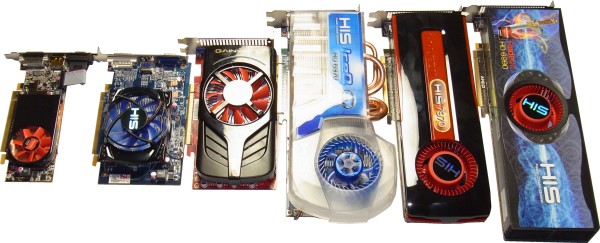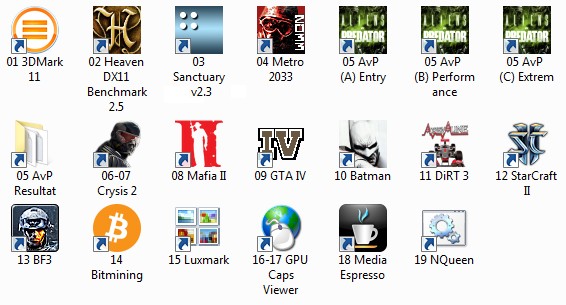Meet The 2012 Graphics Charts: How We're Testing This Year
It's time to revamp the Graphics Charts section! For 2012, we're increasing the number of games and resolutions, dividing the results into three segments. But that's not all. We also include GPGPU benchmarking, power consumption, temperature, and noise.
Preset Levels: Entry-Level, Performance, And Extreme
Three Separate Preset Levels Ensure a Fair Evaluation
In order to assess a broad spectrum of graphics cards, we also expanded our benchmark-based performance index by adding a whole category. Starting at the bottom, the “Entry-Level” segment for budget-oriented cards comes first. The levels of resolution, image quality, and performance that can be expected from such cards are exemplified by the Radeon HD 6790 and the GeForce GTX 550 Ti. Two typical cards you'll find in the “Performance” category are the GeForce GTX 560 Ti and Radeon HD 6950. Finally, the “Extreme” category contains graphics cards like the Radeon HD 7950 and the GeForce GTX 580. Yes, the GTX 680 is coming as well, but we didn't get it in time for this first round of testing.
We raised the bar for each of the performance categories, as we've already seen new boards based on 28 nm GPUs up the ante significantly for graphics performance. A score of 100% in a category means that the card fully achieves the requirements of that specific segment. Note that performance (and the associated score) can vary from game to game and across driver versions. We also tried to choose the benchmarks in a way that doesn't favor either GPU vendor. We're confident that our benchmark selection results in a fair performance assessment of a particular graphics card.
| Level | Resolution | Graphic Settings |
|---|---|---|
| Entry | 1280x720 (720p) | -Minimal to mid-level quality settings -No anti-aliasing -Medium anisotropic filtering -No ambient occlusion -Minimum tessellation depth -Normal texture quality |
| Performance | 1920x1080 (1080p) | -High quality settings -Simple to mid-level anti-aliasing -Maximum anisotropic filtering -Medium tessellation depth -High texture quality, but no HD textures |
| Extreme | 2560x1440 | -Maximum quality settings -Maximum anti-aliasing level (w/o driver tweaks) -Maximum anisotropic filtering -Maximum tessellation depth -Maximum texture quality, HD textures |
Let's turn now to a discussion of the different benchmarks we're using in 2012.
Get Tom's Hardware's best news and in-depth reviews, straight to your inbox.
Current page: Preset Levels: Entry-Level, Performance, And Extreme
Prev Page Selecting A Monitor And Choosing Resolutions Next Page Synthetic Graphics Benchmarks
Igor Wallossek wrote a wide variety of hardware articles for Tom's Hardware, with a strong focus on technical analysis and in-depth reviews. His contributions have spanned a broad spectrum of PC components, including GPUs, CPUs, workstations, and PC builds. His insightful articles provide readers with detailed knowledge to make informed decisions in the ever-evolving tech landscape
-
johnny_utah While I love the new techniques, using BITCOIN to bench GPUGPU performance instead of Folding @ Home? Um, okay.Reply -
Still with the bar charts? Would *love* to see scatter plots with price/score on the axes... So much more useful in picking out a card.Reply
-
AznCracker Man the charts are dying to be updated. Too bad it isn't done more often since it takes a lot of work.Reply -
pharoahhalfdead johnny_utahWhile I love the new techniques, using BITCOIN to bench GPUGPU performance instead of Folding @ Home? Um, okay.Reply
I agree. I know Tom's spends a lot of time benchmarking, but Folding@home is something that is a bit more common. I would love to see F@H in some articles.
BTW, I appreciate all the work you guys do. -
randomkid Where's the 5760x1080? In the area where I come from, 3x 1920x1080p 22" monitor cost around the same or even less than a single 2560x1440/1600 27" monitor so this is a more likely configuration among gamers.Reply
The 5760x1080 resolution will also push the GPU's harder than a 2560x1440/1600 could so why limit the resolution there? -
Reply
We'll add up to 20 new boards each month until the lower end of the performance range is filled out, too.
How far back in GPU generations are you going to test, if at all? I saw the power consumption charts and could only see GTX 500, 600 and Radeon 6000, 7000 series. I have an EVGA GTX 480 SC for two years and do like to know how it compares to the newer series of GPUs. Much appreciated. -
Yargnit MMO FanYup no surprise here typical Nvidia benchmark suite fuck sakes.Reply
So what would YOU like to see used then? If they were trying to push Nvidia wouldn't Hawx 2 be in the suite? -
shinym For Starcraft II you say "This game doesn't stress the CPU, and is thus well-suited for GPU benchmarking." Looks like you got CPU and GPU mixed up there.Reply

